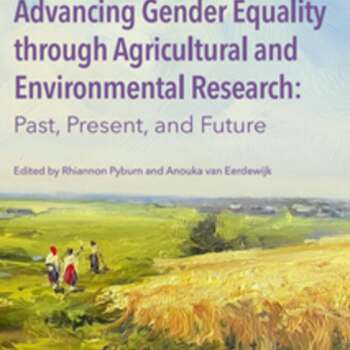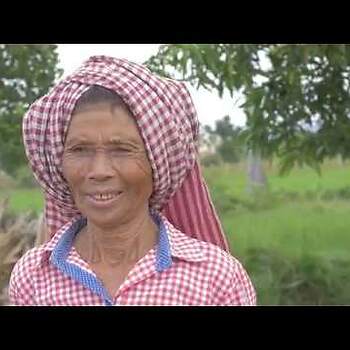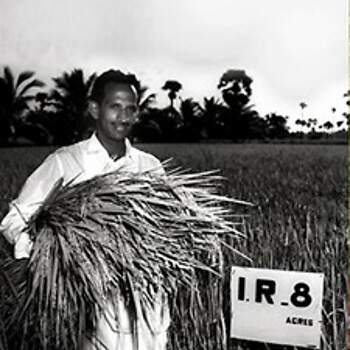The Green Revolution
The Green Revolution refers to the set of research technology transfer initiatives to significantly increase agricultural production, mainly promoted and implemented between 1950 and the end of the 1960s. These technology transfers included the use of High Yielding Varieties (especially of cereals), chemical fertilizer, agrochemicals, irrigation and mechanization, often doubling the production in tons/ha. Because total food production increased, famines and malnutrition were reduced, e.g. in India. There were also negative spill-offs, such as pulse crops being replaced by wheat (lower nutritional value), farmers going into debt (leading to increased rural-urban migration), and mechanisation replacing manual labour. Moreover, the HYVs require high input levels of external inputs, which also mean higher risks.
Technology focus
The Green Revolution had a strong technology focus. Agricultural extension was meant to introduce these technologies, focusing on male household heads. Women were usually not seen as farmers.
Based on writings by Janice Jiggins, FAO in 1986 concluded that though the Green Revolution brought major social benefits, at the same time significant costs were generated for particular categories of women, which were different in kind and intensity from those experienced by men. In particular, the introduction of HYV of rice in Asia had a major impact on rural women’s work and employment, most of it unfavourable, by:
- increasing the need for cash incomes in rural households to cover the costs of technological inputs which has forced women to work as agricultural labourers
- increasing the need for unpaid female labour for farming tasks thereby augmenting women's already high labour burden
- displacing women's wage earning opportunities through mechanization.
The article recommends that women have to be recognised as a constituency for agricultural research.
Stakeholders
Various stakeholders supporting the Green Revolution, such as the Ford and Rockefeller Foundations, were also key in establishing agricultural research institutes. In 1960 the International Rice Research Institute (IRRI) was established in the Philippines, which led in 1966 to the development of IR8, a semi-dwarf high yielding rice variety, then called ‘miracle rice’ increasing rice yields from 1-2 tons/ha to 4-5 tons/ha. In 1971 the Consultative Group on International Agricultural Research (CGIAR) was established supported by FAO, IFAD and UNDP, as a network of (in 2022) 15 agricultural research centres. Over time, gender equality and women farmers have become well integrated into CGIAR’s work.
About CGIAR and Gender
CGIAR is a global partnership uniting 15 international agricultural research institutes engaged in research about food security, thereby aiming to reduce rural poverty, and improve human health, nutrition, and sustainable management of natural resources. Over the years the original mission -to solve hunger- expanded to transforming the world’s food, land and water systems to meet the demands of the 21st century, with special attention to the climate crisis. Integration of gender perspectives in all its work has become standard.
CGIAR estimates that women make up 43 percent, on average, of the agricultural labour force in low- and middle-income countries. Understanding their roles, knowledge and needs, and the barriers they face, is essential to achieve CGIAR’s goal, including the demands of women themselves. Gender research is thus a crucial component of inclusive and impactful agricultural research and innovation. In CGIAR’s new 10-year research and innovation strategy for food, land, and water system transformation, launched at the start of 2021, gender equality is one of five priority impact areas.
A recent IFPRI publication on advancing gender equality in agricultural and environment research shows that gender within CGIAR’s work means more than including women as farmers. Rather, CGIAR aims for gender equality through transformative change, thereby empowering women through value chain participation, promoting nutrition-sensitive agriculture and enhancing women’s agency in climate adaptation and mitigation.
From staple grains to food system
In the aftermath of the Green Revolution, emphasis on staple grains, such as rice, wheat and maize, remained until the early 1980s. Since then there was a moving away from staples to look more at the broader food system ‘from farm to fork’, including to enable more diversified diets.
Within development cooperation attention to agriculture started to dwindle. It was especially the World Bank’s World Development Report of 2008 on Agricultural Development, in the same year that food prices and the number of malnourished people in the world peaked again, that put renewed emphasis on agriculture, especially as an effective instrument for economic development that favours the poor. This report recognized the importance of gender issues within the agricultural sector, stating that “Where women are the majority of smallholder farmers, failure to release their full potential in agriculture is a contributing factor to low growth and food insecurity”.
Other approaches
As a reaction to the Green Revolution other approaches developed over time, such as LEISA, agroecology and climate-smart agriculture, depending less on external inputs and more resilient to adverse weather conditions. These farming systems have put farmers -men and women- central for achieving sustainable food production, thus gender concerns are integral to their approaches. See the example of women and agroecology.
Women and agroecology
Agroecology is farming that centres on food production by making the best use of nature’s goods and services while not damaging these resources. It is not a new invention, as it is already described in the 1920s. Agroecological farmers seek to improve food yields for balanced nutrition, strengthen fair markets for their produce, enhance healthy ecosystems, and build on ancestral knowledge and customs. The ‘10 elements of Agroecology’, developed through a multistakeholder process by FAO, recognize that agroecology seeks to address gender inequalities by creating opportunities for women. In particular, it is stated that:
“Agroecology can help rural women in family farming agriculture to develop higher levels of autonomy by building knowledge, through collective action and creating opportunities for commercialization. Agroecology can open spaces for women to become more autonomous and empower them at household, community levels and beyond – for instance, through participation in producer groups. Women’s participation is essential for agroecology and women are frequently the leaders of agroecology projects.”
As a bottom-up, grassroots paradigm for sustainable rural development, agroecology empowers people -women and men- to become their own agents of change!
Read more on agroecology and gender:
https://www.agroecologyfund.org/what-is-agroecology;
https://focusweb.org/publications/women-agroecology-gender-equality/


